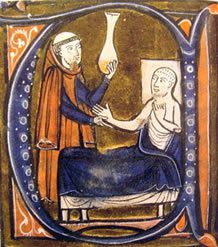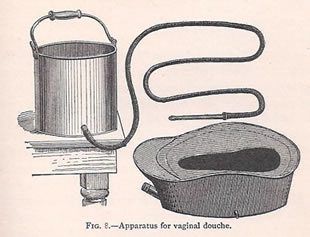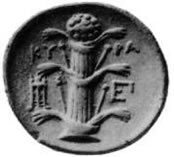Emily R. W. Davidson
Chapel Hill, United States

Depiction of Al-Razi, 1250-1260
From Gerard of Cremona’s
Recueil des traités de médecine
Since the advent of the birth control pill, birth control advocates claim that women’s control over their reproductive potential increased the proportion of women in the US workforce over the course of the 20th century (Fig 1). Long before the oral contraceptive pill’s emergence, however, women found ways to control their fertility. Ancient documents from all over the world—including a nearly 4,000-year-old Egyptian document titled the Kahun Gynecological Papyrus—describe various forms of pregnancy control. Among the various forms of contraception described emerge three clear categories of contraception: techniques, herbo-pharmacology, and devices.
Contraceptive techniques
And Judah said unto Onan, go in unto thy brother’s wife, and marry her, and raise up seed to thy brother. And Onan knew that the seed should not be his; and it came to pass, when he went in unto his brother’s wife, that he spilled it on the ground, lest that he should give seed to his brother.
From Genesis 38:8-9
This reference from the Old Testament describes coitus interruptus, colloquially known as the withdrawal method. While this method is a reliably poor method for preventing pregnancy, it is also one of the oldest. Persian physician Muhammad ibn Zakariya al-Razi also wrote of this technique. Coitus interruptus also seemed to be of religious significance in ancient China. Master Tung-H’suan described the technique in his writings, although his focus seemed to be less for birth control and more for preservation of the man’s yang.
This Chinese physician also advocated for a technique related to coitus interruptus called coitus obstructus. In this technique, men would put pressure on the forepart of the testicle to prevent sperm’s passage into the woman. Ancient Sanskrit texts described this method as well. Another related technique found in Hindu texts was that of coitus reservatus; this form of contraception was simply the deferment of ejaculation by the male partner.

First recorded in the Kahun Gynecological Papyrus, the continuation of breast-feeding was another ancient form of birth control. Modern women still use this method under the medicalized term “the lactational amenorrhea method.” This likely developed, like many other forms of birth control, from observation of domestic animals’ breeding habits during pre-history.
Douching, while now marketed as a form of “female hygiene,” has also been used as birth control up until the 19th century (Fig 2). In fact, douche products’ placement on the pharmacy shelves as “vaginal hygiene” is related to the fact that these preparations were illegal if used as birth control. Yet these douches were so important that recipe books from the 1800s included instructions for their preparation. These preparations would include a variety of ingredients such as savin and pennyroyal that were thought to have contraceptive properties. These products were neither effective nor always safe. If not diluted properly, they could cause severe vaginal or vulvar burns.
Obviously, not all published techniques for birth control were effective. For example, a Greek physician named Soranus published a widely distributed medical book simply called Gynecology circa 130 CE. Within the text, he described a post-coital technique that women could control, unlike coitus interruptus, reservatus, and obstructus. Women were to squat after intercourse and sneeze in an effort to remove the ejaculate from within her womb. A physician named Dr. Russell Thacker cited this text in his book, Sexual Physiology, published in 1866. In both ancient Greece and Thacker’s post-civil war era, there was a baby boom after publication of both texts.
Contraceptive herbo-pharmacology

Ancient Cyrenaic silver coin
depicting a stalk of silphium

Queen Anne’s lace,
or wild carrot
Before pharmaceutical companies produced medication through complicated biochemistry, women relied on knowledge of herbs and plants passed down for generations as contraception. Methods included the douche (also known as a female preparation), vaginal suppositories, teas, and oral physiks that could serve as either contraceptives or abortifacients. Some important plants included rue, artemisia, marjoram, parsley, thyme, lavender, worm fern (also known as prostitute root), and Queen Anne’s lace or wild carrot (Fig 3). Modern science has demonstrated that Queen Anne’s lace truly does have post-coital anti-fertility properties, and women in India still chew these seeds for its contraceptive benefits while some women in rural North Carolina reportedly still drink the seeds after intercourse.
Perhaps the most important plant in historical contraception was silphium (Fig 4). Also known as laser wort, silphium was a giant fennel plant only found on the coastal city of Cyrene in modern-day Libya. Because of its contraceptive properties, it was supposedly worth “more than its weight in gold.” So revered was this plant that its image was placed on the four-drachma coin—the reverse side of the coin showed a naked woman gesturing to the plant with one hand and pointing to her genitals with the other. Perhaps because of its widespread use and subsequent over-harvest, silphium became extinct between the 2nd and 3rd century BCE. Its impact, however, remains today. Silphium seeds were heart-shaped, and some historians theorize that the heart shape is still associated with love or sex because of the plant.
Contraceptive devices
“Rubbers” have been around long before the vulcanized substance for which they were nicknamed. Early condoms were made of multiple materials including animal or fish bladders or intestines. Very thick, the condoms were perceived to be too thick to permit much pleasure for the men wearing them. In the mid-1500s, the anatomist Gabriel Fallopius in Padua designed medicated sheaths made of linen. These sheaths included a pink ribbon to tie around the base of the penis and were nicknamed “overcoats.” While these were designed to deter venereal diseases, they were still important in the history of contraceptive technology. In the 1870s, vulcanized rubber condoms were developed, but they were still a far cry from the disposable thin version currently in use. In the late 19th century, men reused condoms until they were broken or cracked. In the 1930s thin, latex condoms were finally available that were not only disposable but improved sensation for men.
The cervical sponge is another device with ancient roots. Even the Talmud refers to a sponge: “there are three women that may cohabit with a sponge: a minor, a pregnant woman and one that nurses her child.” It has been made out of a variety of materials. Cotton sponges were used in historical Islamic culture, Greek, and ancient Jewish culture. Slavic women used linen rags as sponges, and there is evidence that ancient Japanese prostitutes used balls of bamboo tissue paper in the same way. Like modern sponges that include spermicide, these ancient devices were often soaked in iodine, alcohol, quinine, and carbolic acid.

Pessaries are now used for women with incontinence and pelvic organ prolapse, but were originally used for contraception in early ancient Egypt. Even the famous seducer Giacomo Casanova was rumored to use halves of lemon rinds to cover the cervix of his sexual conquests (Fig 5). Acacia gum pessaries, mixtures of honey and sodium carbonate, and caps made of elephant or crocodile dung were also used, as mentioned in the Kahun Gynecological Papyrus.
Related to the pessary, modern diaphragms were first introduced in 1870 in Germany, only 26 years after Goodyear patented the vulcanization process. Developed by anatomist and physician C. Haase (but sold under the pseudonym Willhelm Mensinga), the first cap was sold as “The Occlusive Pessary” but was commonly known as the “Dutch Cap.” It was a rubber hemisphere with a watch spring around the head of the device that held it in place. Supposedly, this diaphragm was 98% effective. Diaphragms were very important to American history after Margaret Sanger introduced them to the United States in 1932. In 1936 her attempt to import Japanese diaphragms helped overturn the Comstock Act, legislation that previously censored contraceptives and contraceptive information from being distributed through the US Postal Service.
The intrauterine device (IUD) is currently the most effective form of contraception, more effective than even surgical tubal ligation. In 1928, German physician Ernst Grafenberg developed one of the first IUDs. It was a metal-coil loop, commonly known as the “silver loop.” Unfortunately, after insertion the insertion of Grafenberg’s many women did develop pelvic inflammatory disease (PID); similarly, the Dalkon shield, another IUD aggressively marketed to American women in the 1970s, resulted in significant numbers of PID among users.
It is fortunate that many descriptions of birth control have been found. It is sure, though, that like silphium, other methods have been lost over time. Historian John H. Riddle theorizes that the loss of this folk knowledge can be attributed to attempts from the church and government to repopulate the world after plague epidemics. These anti-contraception movements led to “witch hunts” of women and midwives who were the members of society with the appropriate herbal and technical expertise. Unfortunately, many of these anti-contraceptive perspectives are still found today in modern culture. Today, some ancient contraceptive methods seem horrific and unthinkable while other methods are still in common practice, but all historical forms of birth control paved the way for the reproductive freedom that modern technologies now afford women.
Suggested reading
- Bellows, A. (2007, May 21). The birth control of yesteryear. Retrieved from http://www.damninteresting.com/the-birth-control-of-yesteryear/
- Estes, J. (1991). The medical skills of ancient Egypt. In Carmichael and Ratzans (Eds.), Medicine, a treasury of art and literature. New York: Hugh Lauter.
- Goldin, C. and Katz L.F. (2002). The power of the pill: Oral contraceptives and women’s career and marriage decisions. Journal of Political Economy, 110: 730-770. Retrieved from http://scholar.harvard.edu/goldin/cgoldin/files/the_power_of_the_pill_oral_contraceptives_and_womens_career_and_marriage_decisions.pdf
- Jordan, M. (1999, Sept 21). Selling birth control to India’s poor: Medicine men market an array of contraceptives. Wall Street Journal.
- MacCormack, C. (1994). Ethnography of Fertility and Birth 2nd ed. Prospect Heights: Waveland Press.
- Our Bodies, Ourselves. (2012). A brief history of birth control. Retrieved from http://www.ourbodiesourselves.org/book/companion.asp?id=18&compID=53
- Panati, C. (1989). Panati’s extraordinary origins of everyday things. New York: Harper and Row.
- Public Broadcasting Service (Producer). (2003). The American experience: The pill [DVD]. Available from http://www.pbs.org/wgbh/amex/pill/index.html
- Riddle, J. (1997). Eve’s Herbs. Cambridge: Harvard University Press.
- Riddle, E. & Riddle, R. (1995). In Hasten, L (Ed.), Ever since Eve: Birth control in the ancient world. Annual Editions Archaeology 95/96. Guilford: Dushkin Publishing Group, Inc.
- Riddle, J. M. (1992). Contraception and abortion from the ancient world to the Renaissance. Cambridge, Massachusetts: Harvard University Press.
EMILY R. W. DAVIDSON, MD, is a recent graduate from the University of Chicago’s Pritzker School of Medicine. She wrote this paper as a fourth-year medical student in Dr. Mindy Schwartz’s History of Medicine course. She attended Indiana University in Bloomington, Indiana, for her undergraduate training. She is currently a first-year resident physician at the University of North Carolina Hospital in Chapel Hill in the department of Obstetrics and Gynecology.
Highlighted in Frontispiece Fall 2012 – Volume 4, Issue 4

Leave a Reply